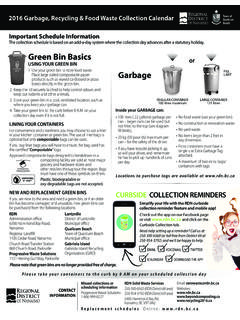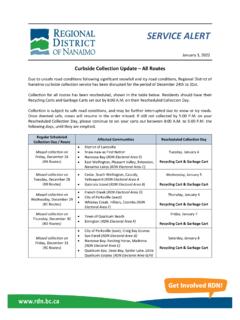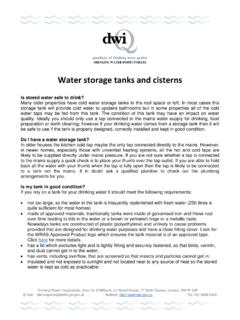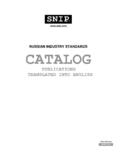Transcription of BEST PRACTICES GUIDEBOOK - Regional District of Nanaimo
1 GREEN BUILDING SERIES. Rainwater Harvesting best PRACTICES GUIDEBOOK . DEVELOPED FOR HOMEOWNERS of the Regional District OF Nanaimo . British Columbia, Canada Residential Rainwater Harvesting Design and Installation Regional District OF Nanaimo GREEN BUILDING best PRACTICES GUIDEBOOK . SYMBOLS MESSAGE FROM THE CHAIR. Special symbols throughout Regional District OF Nanaimo . this GUIDEBOOK highlight key information and will help you As one of the most desirable areas to live in Canada, the Regional District of Nanaimo will continue to experience population growth. This growth, in turn, triggers increased to find your way. demands on our resources. At the same time, residents of the region are extremely focused on protecting our water supplies, and are keen to see progressive and proactive HANDY CHECKLISTS approaches taken to manage water in a sustainable manner.
2 The RDN is committed to protecting the Region's watersheds through water conservation. Conservation will be accomplished by sharing knowledge and supporting innovative actions that achieve more e cient and sustainable water use. One such action is the harvesting of rainwater. EXTRA CARE & PRECAUTIONS. Rainwater harvesting is the collection and storage of rainwater for potable and non- potable uses. With the right controls in place, harvested rainwater can be used for irrigation, outdoor cleaning, ushing toilets, washing clothes, and even drinking water . CONSULT A PROFESSIONAL Replacing municipally-treated water or groundwater with rainwater for these uses alleviates pressure on Regional aquifers and sensitive ecosystems, and reduces demands on municipal infrastructure.
3 Stored rainwater provides an ideal source of readily available water , particularly during the long dry summers or in locations facing declining REFER TO ANOTHER SECTION groundwater levels. This Rainwater Harvesting best PRACTICES GUIDEBOOK provides useful information for residents who wish to learn more about the bene ts and opportunities of rainwater harvesting CLEVER TIPS for non-potable and potable purposes. As an information source speci c to the RDN's location and climate, the GUIDEBOOK is a valuable resource for RDN residents building their own rainwater harvesting systems or working with professionals to do so. CALCULATIONS With this GUIDEBOOK , the RDN continues to lead the way in protecting watershed health, and in promoting sustainable approaches to the management of water one of our most precious natural resources.
4 Joe Stanhope, Chair of the RDN Board This Rainwater Harvesting best PRACTICES GUIDEBOOK Research, Original Text & Technical Photography: BOB BURGESS, RAINWATER CONNECTION. has been produced by the Regional District of Nanaimo (British Columbia, Canada), in partnership with the following local organizations specializing in sustainability: Technical Illustrations: KEENE ANDERSON, GREENPLAN & ASSOCIATES. Editor/Designer: CRYSTAL SAWYER, TRIVENI WEST COMMUNICATION GROUP. RESIDENTIAL RAINWATER HARVESTING DESIGN AND INSTALLATION. TABLE OF CONTENTS COLOURS. Coloured tabs near the top 1. INTRODUCTION. The Importance of Rainwater Harvesting Within the RDN _____ 1. edge of pages indicate that Scope of this GUIDEBOOK _____ 2 the page (or portion of the Chapter Summary _____ 3 page) refers to RWH systems Quick Self-Assessment: Is Rainwater Harvesting Right for You?
5 _____ 3. designed for water that is A Note on Units _____ 4. Planning & Professionals _____ 5. either Non-Potable (Outdoor Using the Right Professionals _____ 5 Use), Non-Potable (Indoor Compliance with Building Codes, Local Regulations and Bylaws _____ 6 Use), or Potable. Other Sources of Information _____ 7. 2. AN INTRODUCTION TO RAINWATER HARVESTING. THIS INFORMATION SPECIFIC. Rain A Precious Resource _____ 9. TO NON-POTABLE. What is a Rainwater Harvesting System? _____ 10 (OUTDOOR USE) RWH SYSTEMS. Three Categories of RWH Systems _____ 10. Non-Potable (Outdoor Use) RWH Systems _____ 10. Roof, Gutters and Downspouts _____ 11 THIS INFORMATION SPECIFIC. Catchment System _____ 11 TO NON-POTABLE.
6 water Diverter _____ 12 (INDOOR USE) RWH SYSTEMS. water storage Tank _____ 12. water Distribution System _____ 12. Non-Potable (Indoor Use) RWH Systems _____ 13 THIS INFORMATION SPECIFIC. Roof, Gutters, and Downspouts _____ 14 TO POTABLE (DRINKABLE). RWH SYSTEMS. Catchment System _____ 14. water Diverter _____ 14. water storage Tank _____ 14. water Distribution System _____ 14. Potable RWH Systems_____ 15. Roof, Gutters and Downspouts _____ 16. Debris Removal Devices _____ 16. First Flush Diverter (FFD) _____ 17. Potable water Rated Components _____ 17. water Disinfection Equipment _____ 17. DISCLAIMER: The RDN assumes no responsibility for the performance of any rainwater harvesting system designed or installed, whether in reliance on this handbook or otherwise, and makes no warranty or representation regarding the quality, safety or potability of any water obtained through such a rainwater collection system.
7 Regional District OF Nanaimo GREEN BUILDING best PRACTICES GUIDEBOOK . 3. CALCULATING water SUPPLY, DEMAND AND storage REQUIREMENTS. Supply: How Much Rainwater Can I Collect? _____ 19. Amount of Precipitation in Your Area (Potential Rainwater) _____ 19. Size or Footprint of Your Roof (Roof Catchment Area) _____ 21. Proportion of Total Rainfall You Can Collect (Collection E ciency) ____ 22. Calculating Actual Annual Rainwater Collection _____ 22. Calculating Monthly Rainwater Collection _____ 24. Demand (How Much water , and for Which Purposes?)_____ 25. water Conservation _____ 25. Garden Watering _____ 26. Outdoor Cleaning and Hot Tubs _____ 26. Toilet Flushing _____ 26. Other Indoor water Uses _____ 26.
8 storage : How Much Rainwater Do I Need to Store? _____ 27. Determining Tank Size Using water Balance Tables _____ 27. Case Example: water storage . Non-Potable (Outdoor Use) RWH System_____ 28. Case Example: water storage . Potable RWH System for a Three-Person Household _____ 30. Fire and Emergency water Reservoirs_____ 31. 4. THE COMPONENTS OF A RWH SYSTEM. From Roof to Tap _____ 33. Catching the Rain _____ 34. Roof _____ 34. Snow Rails on Roof _____ 34. Gutters _____ 35. Materials _____ 35. Size _____ 35. Slope _____ 35. Shape _____ 36. Gutter Covers _____ 36. Splash Guards _____ 37. Downspouts _____ 37. RESIDENTIAL RAINWATER HARVESTING DESIGN AND INSTALLATION. Moving the Rain from Roof to Tank _____ 38.
9 Transport Piping Systems _____ 38. Dry Systems_____ 38. Surge/Pump Tank Systems _____ 39. Wet Systems _____ 40. Pipe Size and Slope _____ 41. Rainwater Transport Pipe Types_____ 41. Cleaning the Rain _____ 42. Debris Removal Devices _____ 44. First Flush Diverters (FFDs) _____ 45. How Does a FFD Work? _____ 45. When to use a FFD _____ 46. FFD water Rejection Quantities _____ 46. Types of FFD's _____ 48. Wall Mounted Pipe _____ 48. Underground FFD Pipes _____ 48. Box or Barrel FFD's _____ 49. Dripper Ends _____ 49. FFD Pipe Sizing _____ 49. Storing the Rain _____ 50. Types of Cisterns _____ 50. Outdoor Above-Ground Tanks _____ 50. Outdoor Below-Ground Tanks _____ 50. Indoor Tanks _____ 50.
10 Cistern Size _____ 51. Cistern Site Placement _____ 53. Leveraging Gravity _____ 53. Aesthetics _____ 54. Neighbourliness _____ 54. Allowing for Future Expansion _____ 54. Tank Installation Checklist_____ 55. Tank Safety Checklist _____ 56. Optional Tank Features _____ 56. Regional District OF Nanaimo GREEN BUILDING best PRACTICES GUIDEBOOK . Pressurizing the Rain _____ 57. Pump Pressure or Head _____ 57. Selecting the Appropriate Type of Pump _____ 58. Types of Pump Systems _____ 58. External Constant Speed Pump with a Pressure Tank _____ 58. On-demand Pumps_____ 59. Submersible Pumps _____ 60. Pump Safety Checklist _____ 60. Purifying the Rain _____ 61. Rainwater Puri cation for Potable RWH Systems _____ 61.







